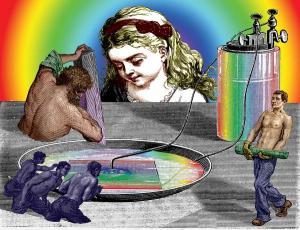Sale on canvas prints! Use code ABCXYZ at checkout for a special discount!

Here is an excerpt from my new blog at http://retrocollage.blogspot.com/
The power of collage lies in its ability to “cut to the chase.” By relying on readymade images of objects instead of creating them from scratch, the collagist benefits from a complex web of associations already attached to each image by other people. When these “accepted” images are combined in unexpected ways, their respective attached associations combine as well -- colliding, amplifying, distorting each other--and the result can move the viewer’s perceptions and emotions profoundly, while giving birth to a new world.
I began to love printed paper in late infancy. In my crib, I would spend hours looking through the picture pages of magazines, carefully tearing them out and piling them to one side. I suspect that this activity was a precursor of the collage work I have done since.
When I was six years old, I saw wood engravings for the first time, in a Czech fantasy film based on a Jules Verne novel. The director had collaged these fascinating images into animated compositions: fish swam, butterflies flitted from place to place, pistons and gears slid and rotated with clockwork precision. Three years later, I happened upon Max Ernst's collages of nineteenth century engravings, from his pictorial novel A Week of Kindness (Une Semaine de Bonté). These two experiences awakened in me a love of wood engravings and an understanding of their pictorial power when juxtaposed.
The collages shown here present unconscious and preconscious themes: dreams, emotional associations, desires, ancestral memory, and the cultural collective unconscious. While combining images, I attempt to allow them to speak to one another, to guide and direct the process of collage-making with as little conscious interference as possible.